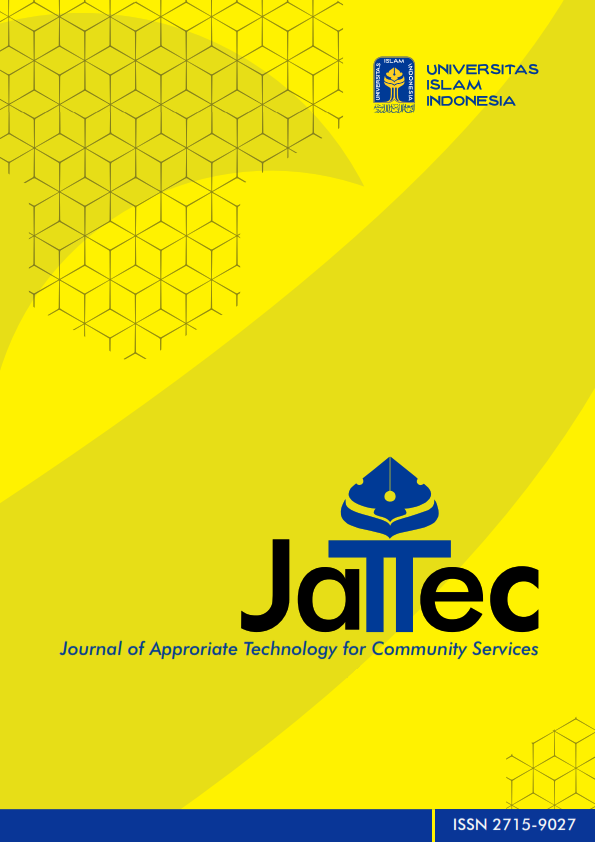Main Article Content
Abstract
Electricity consumption in Indonesia from year to year has increased. The sales of PLN 2018 electricity in 234,617.88 GWh covering industrial sector, household sector, commercial sector, and public sector. While electrical energy consumption in D. I. Yogyakarta in 2018 of 2,857.06 GWh covering household sector, industrial sector, business sector, social sector, government office building sector and public street lighting. In fulfilling the demand of electrical energy, Yogyakarta installed power plant consists of PLTMH, PLTBm, PLTS and PLTHybrid with an installed capacity of 4.84 MW so that electricity in Yogyakarta is supplied from the interconnection network of Java-Madura-Bali. Energy resources used by interconnection networks generally use fossil energy (coal). Therefore we need a substitute for future fossil fuels. Utilization of renewable energy is one of the solar energy optimizations that can be applied to urban areas. The building sector consumes up to 40% of total annual energy. One of the buildings that can apply the utilization of renewable energy is the office building PUP-ESDM D. I. Yogyakarta. This research aims to know the potential power generated from the PLTS roofing if it is built on the office building Public Works, housing and Energy Mineral resources (PUP-ESDM) D. I. Yogyakarta. Research is conducted by conducting energy simulations using the HelioScope software. Simulated results show the east side of Building 1, the east side of Building 2, the east side of Building 3, the west side of Building 2 and the north side of Building 2 is the optimal location of photovoltaics. The Total energy potential generated from these five roofs is 73,484.5 kWh/year and is able to supply the energy needs of the PUP-ESDM office by 74.42%.
Article Details
References
- Badruzzaman, Y. (2013). Roadmap Energy di Provinsi Daerah Istimewa Yogyakarta. Jurnal Teknik Elektro Terapan, 2(1), 18 – 30.
- Buresh, M. (1983). Photovoltaic Energy System Design and Installation, McGraw Hill Book Company, United States of America.
- Hasan, H. (2012). Perancangan Pembangkit Listrik Tenaga Surya Di Pulau Saugi. Jurnal Riset dan Teknologi Kelautan, 10(2). 169-180.
- Putra, T. G. (2015). Analisa Unjuk Kerja Pembangkit Listrik Tenaga Surya 15 Kw Di Dusun Asah Teben Desa Datah Karangasem. Skripsi, Universitas Udayana.
- Salman, R. (2013). Analisis Perencanaan Penggunaan Sistem Pembangkit Listrik Tenaga Surya (PLTS) Untuk Perumahan (Solar Home System). Majalah Ilmiah Bina Teknik, 1(1), 46-51.
- Statistik Ketenagalistrikan 2018. (2019). Direktorat Jenderal Ketenagalistrikan Kementerian Energi dan Sumber Daya Mineral. Jakarta.
- Statistik PLN 2018. (2019). Perusahaan Listrik Negara (PLN). Jakarta.
- Tarigan, E., Kartikasari, F. D. (2017). Analisis Potensi Atap Bangunan Kampus sebagai Lokasi Penempatan Panel Surya Sebagai Sumber Energi Listrik. Jurnal Muara Sains, Teknologi, Kedokteran dan Ilmu Kesehatan, 1(1), 101-110.
- Umar, N., Bora, B., Banerjee, C., Panwar, B. S. (2018). Comparison of Different PV Power Simulation Softwares: Case Study on Performance Analysis of 1 MW Grid-Connected PV Solar Power Plant. International Journal of Engineering Science Invention (IJESI), 7(7), 11-24.
- UNEP. (2009). Buildings And Climate Change: Summary For Decision-Makers. United Nations Environment Program.
- www.earth.google.com/web/ Akses tanggal 10 Januari 2020.
- www.helioscope.com/designer/ Akses tanggal 11 Juni 2020.
- www.kewsolar.co.uk/techinfo/panels.aspx Akses tanggal 11 Juni 2020.
- www.sunergi.co.id/id/sistem-off-grid Akses tanggal 11 Juni 2020.
References
Badruzzaman, Y. (2013). Roadmap Energy di Provinsi Daerah Istimewa Yogyakarta. Jurnal Teknik Elektro Terapan, 2(1), 18 – 30.
Buresh, M. (1983). Photovoltaic Energy System Design and Installation, McGraw Hill Book Company, United States of America.
Hasan, H. (2012). Perancangan Pembangkit Listrik Tenaga Surya Di Pulau Saugi. Jurnal Riset dan Teknologi Kelautan, 10(2). 169-180.
Putra, T. G. (2015). Analisa Unjuk Kerja Pembangkit Listrik Tenaga Surya 15 Kw Di Dusun Asah Teben Desa Datah Karangasem. Skripsi, Universitas Udayana.
Salman, R. (2013). Analisis Perencanaan Penggunaan Sistem Pembangkit Listrik Tenaga Surya (PLTS) Untuk Perumahan (Solar Home System). Majalah Ilmiah Bina Teknik, 1(1), 46-51.
Statistik Ketenagalistrikan 2018. (2019). Direktorat Jenderal Ketenagalistrikan Kementerian Energi dan Sumber Daya Mineral. Jakarta.
Statistik PLN 2018. (2019). Perusahaan Listrik Negara (PLN). Jakarta.
Tarigan, E., Kartikasari, F. D. (2017). Analisis Potensi Atap Bangunan Kampus sebagai Lokasi Penempatan Panel Surya Sebagai Sumber Energi Listrik. Jurnal Muara Sains, Teknologi, Kedokteran dan Ilmu Kesehatan, 1(1), 101-110.
Umar, N., Bora, B., Banerjee, C., Panwar, B. S. (2018). Comparison of Different PV Power Simulation Softwares: Case Study on Performance Analysis of 1 MW Grid-Connected PV Solar Power Plant. International Journal of Engineering Science Invention (IJESI), 7(7), 11-24.
UNEP. (2009). Buildings And Climate Change: Summary For Decision-Makers. United Nations Environment Program.
www.earth.google.com/web/ Akses tanggal 10 Januari 2020.
www.helioscope.com/designer/ Akses tanggal 11 Juni 2020.
www.kewsolar.co.uk/techinfo/panels.aspx Akses tanggal 11 Juni 2020.
www.sunergi.co.id/id/sistem-off-grid Akses tanggal 11 Juni 2020.

